Tamu and I woke up in Leavenworth on our final day in Kansas. We had not committed a crime; we just wanted to see some of the town whose name is synonymous with prison. Also, the historic sites and Buffalo Soldier Monument at Fort Leavenworth seemed like they would be interesting and welcoming to visitors despite being on a military base. We headed toward the visitors center and learned that the threat level had increased, so the base had closed to visitors just before the July 4th holiday. It was unclear when it would reopen. The folks at the guard shack were friendly and helpful, but the closure was still in effect as of that morning, so no Buffalo Soldiers or Fort historic sites for us.
After a quick look at our limited Kansas guide, Tamu and I headed to the starting point for the walking/driving self-guided tour of the town. It was a quiet Sunday morning, and as we headed there, we seemed to catch the attention of a police vehicle. At least it seemed like a police vehicle, a black and white sedan seemingly souped up for police use, but when it got closer, it had no insignia on it and the driver did not appear to be in any kind of uniform. We moved away from him when we got to 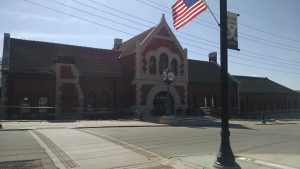 the starting point, but the building with brochures was closed and I felt isolated, so I cut my read of the audio display short and headed to the next one I could find.
the starting point, but the building with brochures was closed and I felt isolated, so I cut my read of the audio display short and headed to the next one I could find.
I stopped at a few, and attempted to listen to the story of the town. But by the second or third stop, the faux-police car returned. It never stopped near me, but it was becoming increasingly hard to dismiss the idea that whoever was driving it was keeping an eye on me, and not for good purpose. I was in the downtown, but people were not stirring much yet on a Sunday morning, so I decided to head to where there was activity and see if I could follow the displays there. I found my way to the city building, and passed a few places serving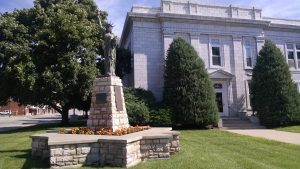 breakfast, but it was too hot to leave Tamu alone in the car. There were a couple of things I wanted to see in Atchison, and I had to be in Iowa City–hours away–for dinner, so I headed out of Leavenworth.
breakfast, but it was too hot to leave Tamu alone in the car. There were a couple of things I wanted to see in Atchison, and I had to be in Iowa City–hours away–for dinner, so I headed out of Leavenworth.
Since it was still morning, I headed first to St. Benedict’s Abbey in Atchison to see if I could make it for Mass. I arrived at the address and discovered that I was just on time, but there was no place to shelter Tamu from the heat. So I tied him up outside the church in a shady spot and listened to the Scripture readings while I prayed he would be okay. I headed out after the Gospel and walked the dog on the nearby campus of Benedictine College. I was surprised to find myself in a small grove of statues celebrating women, and became even more curious when one of them was a likeness of Kenyan Nobel Prize winner Wangari Maathai. Wangari was an environmentalist who turned into a political activist in Kenya when she challenged the use of public 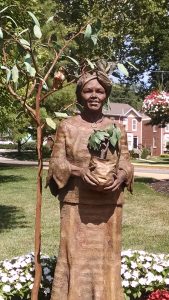 space in Nairobi’s Uhuru Park for development projects that would benefit political allies of the party then in power. Later, when the site was reopened to the public, she led a protest of mothers of political prisoners that was suppressed by the regime. Full disclosure: I happened by the protest while government soldiers were tear-gassing the mamas in 1992, who in turn protested the troops’ actions by removing their clothes–a curse that signals that the recipient is no longer worthy of the most simple human courtesy of covering oneself. Weeks later, after the mamas had received sanctuary at the nearby Anglican cathedral and I was waiting for my weekly choir practice to start there, I met Wangari when she climbed onto the bench were I was sitting to rally the assembled supporters. I gave her a lozenge because her voice was wearing out. She radiated strength and purpose. She was awarded the 2004 Nobel Prize, the first African woman to receive it. Apparently, she is an alumna of Mt. St. Scholastica College, which eventually merged with Benedictine College. But I digress (I could be worse–my masters thesis is about Uhuru Park and memorialization, and I have given a paper on the ritual above); there was more to learn about American women pioneers in Atchison, so I moved on.
space in Nairobi’s Uhuru Park for development projects that would benefit political allies of the party then in power. Later, when the site was reopened to the public, she led a protest of mothers of political prisoners that was suppressed by the regime. Full disclosure: I happened by the protest while government soldiers were tear-gassing the mamas in 1992, who in turn protested the troops’ actions by removing their clothes–a curse that signals that the recipient is no longer worthy of the most simple human courtesy of covering oneself. Weeks later, after the mamas had received sanctuary at the nearby Anglican cathedral and I was waiting for my weekly choir practice to start there, I met Wangari when she climbed onto the bench were I was sitting to rally the assembled supporters. I gave her a lozenge because her voice was wearing out. She radiated strength and purpose. She was awarded the 2004 Nobel Prize, the first African woman to receive it. Apparently, she is an alumna of Mt. St. Scholastica College, which eventually merged with Benedictine College. But I digress (I could be worse–my masters thesis is about Uhuru Park and memorialization, and I have given a paper on the ritual above); there was more to learn about American women pioneers in Atchison, so I moved on.
Tamu and I stopped for a quick lunch in town, walked along the Missouri River, and headed out of 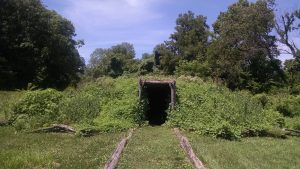 town to see a native settlement. By this point in the trip, I had run out of memory in my camera to narrate what I was doing, and I even had to be selective about photos. I remember being awed by this place, and I think it also explained to me the mystery of the Arkansas/Kansas pronunciation difference that has long perplexed me. But I have lost all this valuable information now. Sigh. Finally, Tamu and I headed to the Amelia Earhart Birthplace Museum, our final stop in Kansas.
town to see a native settlement. By this point in the trip, I had run out of memory in my camera to narrate what I was doing, and I even had to be selective about photos. I remember being awed by this place, and I think it also explained to me the mystery of the Arkansas/Kansas pronunciation difference that has long perplexed me. But I have lost all this valuable information now. Sigh. Finally, Tamu and I headed to the Amelia Earhart Birthplace Museum, our final stop in Kansas.
It was a great finish. The house was built by her grandparents, and Amelia was born and spent much of her childhood there because her father traveled in his work for the railroad. It is a splendid 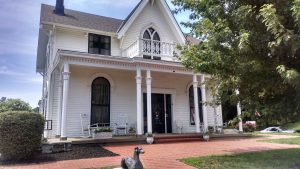 house facing the Missouri River, and the two docents were very welcoming of Tamu, who made himself at home. (So at home, in fact, that I was glad they had things spread out on the aging bedspreads as he was ready to jump on those beds). I must admit that I knew very little about Earhart, so first I wandered around the house learning as much as I could about her childhood and career. I learned she bore such a striking resemblance to her colleague and aviation pioneer, Charles Lindbergh, that they look like
house facing the Missouri River, and the two docents were very welcoming of Tamu, who made himself at home. (So at home, in fact, that I was glad they had things spread out on the aging bedspreads as he was ready to jump on those beds). I must admit that I knew very little about Earhart, so first I wandered around the house learning as much as I could about her childhood and career. I learned she bore such a striking resemblance to her colleague and aviation pioneer, Charles Lindbergh, that they look like 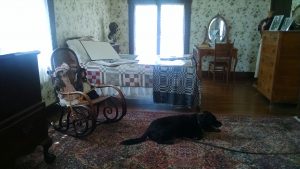 siblings. Once I got my bearings on her life and the house, the docent began sharing about the family and the myths surrounding Earhart’s disappearance over the Pacific in 1937.
siblings. Once I got my bearings on her life and the house, the docent began sharing about the family and the myths surrounding Earhart’s disappearance over the Pacific in 1937.
The docent, a very sharp octogenarian, explained that she believes that Earhart was working for US intelligence at the time and wanted to end her public life, so the US government helped her do this by staging a crash and disappearance. She assumes Earhart continued her government work as a private citizen and lived a quiet life of government service from that point. The docent is certain of this, she quietly explains, because she met Ms. Earhart in the 1980’s when a 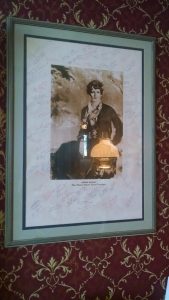 large black government car arrived at the house and a group of black-suited men accompanied an elderly woman around the house. The woman, who was polite and used a name I now forget, seemed familiar with the house and its furnishings, but was confused by some of the additions made later in the house’s history, and was escorted out when she asked too many questions about them. The docent is convinced this was Amelia Earhart herself, being escorted back for a last visit to her childhood home a half century after her disappearance.
large black government car arrived at the house and a group of black-suited men accompanied an elderly woman around the house. The woman, who was polite and used a name I now forget, seemed familiar with the house and its furnishings, but was confused by some of the additions made later in the house’s history, and was escorted out when she asked too many questions about them. The docent is convinced this was Amelia Earhart herself, being escorted back for a last visit to her childhood home a half century after her disappearance.
It seemed like the best possible ending to my Kansas trip. I purchased a few small items in the gift shop and decided to use the Earhart quote as this site’s tagline. Then I headed out for Iowa, hoping that I would find my way back to Kansas and see some of what I missed in this short trip.
